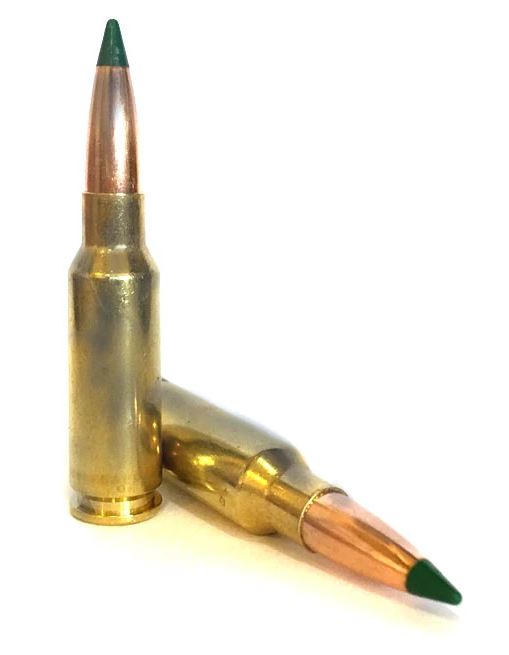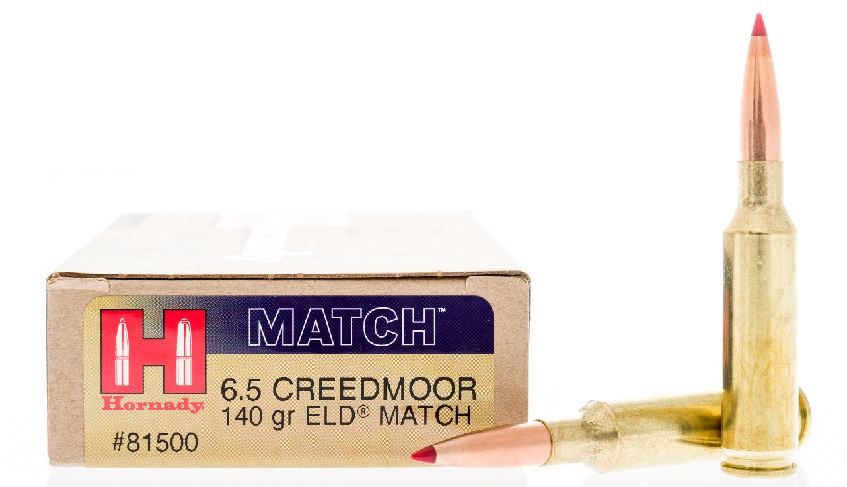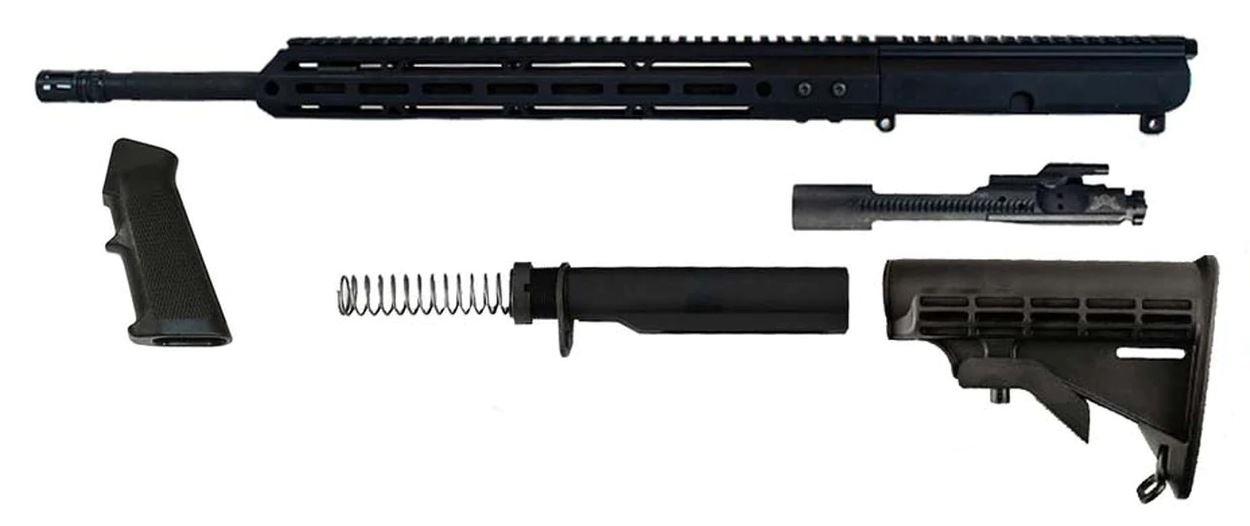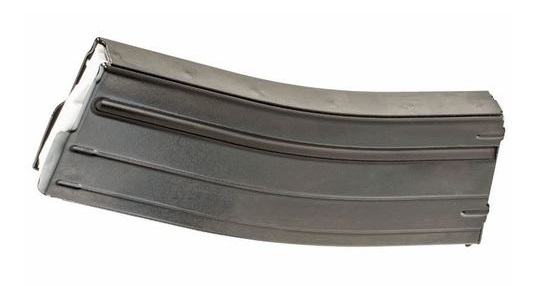6.5 Creedmoor vs 6.5 Grendel
Posted by Gun Builders Depot on Mar 18th 2021
The AR platform hosts loads of calibers. You're no longer stuck with old 5.56 NATO and .223 Remington, or .308 Winchester. Instead, new calibers in the 6.5mm range have allowed both the AR-15 and AR-10 (now sold as the LR-308) to outperform their respective ancestors. But what's the difference between these two rounds? What about ballistics? Most of all, which one should you build? AR kits and 80% lowers exist for both, but they each have advantages and disadvantages. To help you decide, we're comparing the two:
6.5 Grendel

The 6.5 Grendel cartridge is an improved variant of the 6.5mm PPC. It was designed by Bill Alexander of Alexander Arms, who also developed the hard-hitting .50 Beowulf. Interested in packing more power into the AR's short action, Alexander made the Grendel to out-shoot 5.56 NATO and .223 Remington. The round is made to provide low recoil and high accuracy at 200 to 800 meters, with 90- to 130-grain bullets averaging muzzle velocities of 2,700 and muzzle energy of around 1,840 lb.-ft. when fired from a 24" barrel.
Alexander says this load was made specifically to provide better stopping power for hunters, who felt .223 Remington and 5.56 NATO were underpowered for most American game. By employing a long, thin 0.264"-diameter bullet that achieves velocities similar to .223 and 5.56, Grendel naturally provides a much higher ballistic coefficient (BC) and energy downrange.
Grendel Type I vs Type II
Since 6.5 Grendel is trademarked by Alexander Arms, any company who wants to produce components for this round must normally pay royalties to Alexander. But to get around this, some manufacturers (starting with Les Baer Custom) began developing an unofficial clone of 6.5 Grendel, called the .264 LBC. Black Hole Weaponry, a company that produces both official Grendel barrels and .264 LBC barrels, began differentiating between the two loads by referring to .264 LBC as Grendel Type 1, while the official Alexander Arms cartridge was called Grendel Type 2. To avoid legal troubles, Grendel Type 1 has a slightly different bolt face depth to make it truly different from Alexander Arms' cartridge. This has resulted in different headspacing:
- Type 2 ("official") bolts have .136" headspacing.
- Type 1 (.264 LBC) bolts have .125" headspacing.
The Type 1 or .264 LBC load thus requires the use of a 7.62x39mm AR bolt and extractor to operate correctly.
6.5 Creedmoor

6.5 Creedmoor is essentially a longer and more powerful version of 6.5 Grendel. It fires the same, exact 0.264"-diameter bullets as Grendel, while utilizing an even longer casing to provide more powder to burn and thus, more velocities downrange. Creedmoor was developed by Hornady for competition shooting, and is based off the .30 Thompson Center (.30 TC) which is a derivative of .308 Winchester. This guide compares Creedmoor and Winchester in detail.
Hornady's goal in developing 6.5 Creedmoor was to develop a high-BC 6.5mm cartridge that could outperform over .30-caliber loads, while still fitting in the AR-10's and LR-308's short action, in the same manner that Grendel was made to fit in the AR-15's action while outperforming 5.56 and .223. Obviously, Hornady was successful. Creedmoor is capable of maintaining high accuracy up to (and often beyond) 1,000 meters.
Physical Specs Compared
Let's compare these two cartridges' physical specifications as a starting point for our comparisons.
Grendel
- Bullet diameter: 0.264" (6.72mm)
- Case length: 1.520" (38.7mm)
- Parent case: 6.5mm PPC
- Case capacity: 35.0 gr H2O
- Max pressure (SAAMI): 52,000 psi
- Base diameter: .4390" (11.15mm)
- Rim diameter: .0.440" (11.20mm)
Creedmoor
- Bullet diameter: 0.264" (6.72mm)
- Case length: 1.920" (48.8mm)
- Parent case: .30 TC
- Case capacity: 52.5 gr H2O
- Max pressure (SAAMI): 62,000 psi
- Base diameter: .4703" (11.95mm)
- Rim diameter: .4730" (12.01mm)
Overall, Creedmoor's case length is approximately 26% longer than Grendel. This results in a greater case capacity and thus, approximately 19% more max pressure, resulting in greater velocity downrange. Creedmoor and Grendel share the same bullet shape and diameter, but Creedmoor tends to use higher-grain bullets. This additional weight, coupled with more velocity, yields an overall higher ballistic coefficient.
Ballistics
Now that we've got a good idea of how these two rounds' physical specs compare, let's look at how that translates into energy and performance downrange. Let's start with energy, from the muzzle to 500 yards. These data were collected with Grendel running 123-grain AMAX Match bullet and Creedmoor running a 120-grain and 143-grain ELD Match bullet.

Grendel retains approximately 48% of its muzzle velocity at 500 yards. The Creedmoor 120-gr. retains 46% of its muzzle velocity, and the 143-gr. load maintains 56% of its muzzle velocity. It's a close match-up between the two loads, with only Creedmoor's heavier load retaining 8% more velocity compared to Grendel. Let's look at bullet drop from 100 yards to 500 yards next.

It's yet again a pretty close match. Overall Creedmoor retains a flatter trajectory, only rising 1.6" and 1.9" for both 120-gr. and 143-gr. loads, respectively. Grendel rises 2.2" with its 123-gr. load. At 200 yards, though, all loads are dead-on target. Creedmoor's lighter load retains the flattest trajectory, dropping 41.6% at 500 yards, while its 143-gr. load drops 44.4". Grendel drops 52.8" at 500 yards. That's about 11" or 27% more drop compared to Creedmoor 120-gr., and about 8.4" or 19% more drop compared to Creedmoor's 143-gr.
Ballistic Coefficients
Ballistic coefficients measure a bullet's ability to retain a stable flight path, resisting the effects of windage and other environmental factors that throw it off-course. The higher the BC, the greater the hit probability downrange at longer distances. Grendel and Creedmoor's BCs for popular factory loads are displayed:
Grendel BCs
- Hornady 123-grain ELD: .506 BC
- Alexander 123-grain HPBT: .527 BC
- Federal 130-grain ELD: .530 BC
Creedmoor BCs
- Federal 130-grain Edge TRL: .545 BC
- Hornady 140-grain A-MAX: .585 BC
- Berger 140-grain Hybrid: .607 BC
If we compare Grendel's 130-grain and Creedmoor's 130-grain, we find Creedmoor just barely wins with a BC that's approximately 3% higher. This is not surprising, since BC is entirely dependent on bullet weight and shape. Since both loads use the same 0.264" bullets, it becomes a battle of which load provides more velocity and thus, greater resistance to wind and environmental effects. The heavier the bullet, the greater its inertia. More intertia means more force is required to move that bullet off its flight path.
Max Effective Range
Taking all factors into consideration and having tested both cartridges' performance with different bullets, the general consensus is that 6.5 Creedmoor's max effective range is generally 1,000 yards. Grendel's max effective range is generally 800 yards. So, overall, Creedmoor reaches about 20% further downrange than Grendel, which makes sense: It's burning approximately 20% more powder and retains about 20% more velocity, when comparing similar bullet weights between the two cartridges.
Grendel v. Creedmoor: AR-15 or AR-10?

With the data compared, you may think a Creedmoor-chambered AR is the better choice in rifle, except this may not necessarily be the case. Keep in mind that both loads perform similarly up to 500 yards or more, with Creedmoor only providing about 20% more performance, overall. But the rifle is just as important as the cartridge it's chambering, and the AR-15 platform may provide more advantages than the AR-10 and LR-308 platforms.
Q: Why choose a Grendel rifle over Creedmoor?
A: Literally tens of millions of AR-15s exist in the United States. It's the most popular rifle bought and sold, and its huge market has spawned hundreds of manufacturers and parts makers. And, since the Grendel-chambered AR is just like any other AR-15, minus the barrel and bolt, that means you still get access to all the handguards, receivers, parts kits, buttstocks, and accessories AR-15 owners get to customize their rifles with. The AR-10 and LR-308 platforms, not so much. The market for these .308-caliber rifles is much smaller, with fewer parts available to customize and generally higher costs. Remember, like the AR-15, the Creedmoor-chambered AR is just an AR-10 or LR-398 with a different barrel and bolt.
Let's dive deeper into the physical requirements and specs required of both Grendel and Creedmoor rifles. This will help you better determine which platform is best for you.
Barrel Length
6.5 Grendel
Bill Alexander, the guy who designed 6.5 Grendel, was pretty clear in this round's barrel requirements: It needs a 20-inch barrel to perform. Of course, the data we showed in the beginning was pulled from a Grendel rifle with a 24" barrel, but you don't necessarily need that extra bit of velocity to get any noticeably better performance. A 20" barrel will still afford consistent performance up to 800 yards, which is Grendel's advertised max effective range.
JP Rifles compared Grendel barrel lengths and velocity with two rifles, one sporting an 18" barrel and one using a 22" barrel. The 22" barrel provided about 7% more velocity for lighter loads compared to the 18" barrel. Shooting a heavier heavier 129-grain SST load only provided 2.4% velocity with the 22" barrel. If you're chasing max accuracy with heavier match bullets, it's easy to see that a 20" barrel will provide substantially similar performance to a 22" or 24" barrel, based on JP Rifles' tests.
6.5 Creedmoor
Thankfully, we've also got some ballistic testing on a Creedmoor rifle with different barrel lengths compared. Rifle Shooter editors incrementally cut down a 27"-barreled Creedmoor rifle and tested velocity after removing one inch of barrel at a time. They used 120-grain and 142-grain match loads to obtain their data. Interestingly, velocity actually increased when shooting a 142-grain SMK bullet and cutting down from 27" to 24". Shooting a lighter 120-grain load, velocity decreased by just 1.5%, or about 43 FPS. Total loss in velocity remained below 100 FPS when cutting down to just 21" of barrel. Overall, based on these data and what Hornady says, Creedmoor balances size and performance best with a 24" barrel.
Barrel Life
The average 6.5 Grendel barrel will provide good accuracy for 5,000 rounds. The average Creedmoor barrel will get shot out rather quickly: It manages good accuracy with 2,000 to 3,000 rounds. Keep in mind that firing either cartridge from a semiautomatic rifle will generally cause quicker barrel wear because of heat. If you plan on chambering Creedmoor in the AR platform, barrel life could become a concern, especially if you enjoy the occasional mag dump.
Magazine Compatibility

Creedmoor provides one advantage here: It uses standard AR-10 / LR-308 magazines without modification. Grendel loads can become problematic when fed through regular 5.56/.223 magazines, and Grendel-specific magazines are typically required. They cost a bit more than the average "factory" AR magazine.
Ammo Availability & Cost
Simply put, Creedmoor's going to burn a hole in your wallet. While Grendel is more expensive than 5.56 or .223, Creedmoor, compared to .308 Winchester, is much costlier. As of early 2021, the average box of Creedmoor ammo comes out to $2.75 to $3.50 per round. The average box of Grendel ammo comes out to around $1.25 to $2.00 per round.
Parts Compatibility

Upper & Lower Receivers, Parts Kits
Grendel and Creedmoor both fit in their respective platforms' original upper and lower receivers. That means a Grendel AR uses a standard 5.56/.223 receiver set, and Creedmoor AR's use the AR-10 or LR-308 receiver set. That also means you get to use an unmodified or "factory" lower parts kit for either one. Both the AR-15 and LR-308 use a typical AR-15 LPK.
Bolt Carrier Groups
The Grendel uses a regular AR-15 bolt carrier and a Grendel-specific bolt. Remember that you'll need either a Type 1 bolt for a .264 LBC build, which is uncommon, or a Type 2 bolt for an officially trademarked Grendel build. The Creedmoor is a similar situation. It uses a regular .308 bolt carrier with a "high-pressure" bolt and firing pin.
Buffer Systems
You might've guessed by now that either rifle will use a typical buffer assembly. That's correct. Even though LR-308 uses an AR-15 buffer assembly with a "shorty" buffer to accommodate the comparatively longer bolt carrier group, so assembly is relatively straightforward for either cartridge.
Recap
We covered a lot of data and technical info, so here are the key takeaways to remember if you're deciding between building a Grendel or Creedmoor AR or other rifle:
- Both cartridges are 6.5mm and use .264" bullets.
- Grendel's max effective range is about 800 yards.
- Creedmoor's max effective range is about 100 yards.
- A Grendel rifle performs best overall with a 20" barrel.
- A Creedmoor rifle does best with a 22" to 24" barrel.
- The Grendel uses the AR-15 (.223) rifle platform.
- The Creedmoor uses the LR-308 (.308) platform.
DISCLAIMER: If you are new to the world of DIY gun building, you likely have a lot of questions and rightfully so. It’s an area that has a lot of questions that, without the correct answers, could have some serious implications. At GunBuilders.com, we are by no means providing this content on our website to serve as legal advice or legal counsel. We encourage each and every builder to perform their own research around their respective State laws as well as educating themselves on the Federal laws. When performing your own research, please be sure that you are getting your information from a reliable source.

